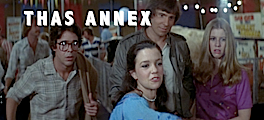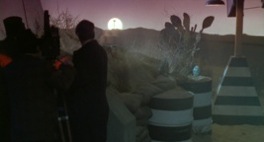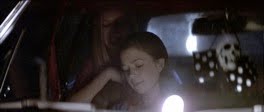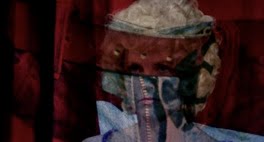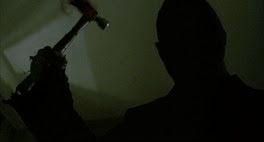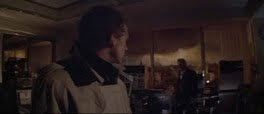These are not ten scenes that make the movies they are a part of. These are not "the best scenes" from said films. Some of these are merely moments - not scenes at all. These are ten scenes, or moments - highly inadequate a number to cover all of Hooper's most striking moments (surely inadequate to represent the inestimable and continuous strength of Hooper's filmography and his ever-constant cinematographic standards). These are not ten scenes that are integral key moments to the films they are a part of - though they may very well be.
These are ten scenes or moments that are marked by their subtlety. So they may not be very conspicuous as being much of "standout scenes" at all, for their subtlety may not warrant such notice anyway - but they may call attention to themselves for just the otherwise. These are ten scenes or moments that may be the moments between the "best scenes": the fluid interstitial, the profound whisperings that connect the profound declamations.
These are ten scenes that are most pressingly ingrained into my imagination, at this moment (although only for having been, for a long time, much more than in this moment, running in my imagination). These are ten scenes that I feel, at this moment, are the most important in understanding Hooper. It is to see him as one of the subtlest, most intelligent of filmmakers. These are frequently the subtlest of scenes, in matters of intelligence or beauty. These are just ten of these scenes, highly inadequate, and since subtlest beauty and intelligence is essentially a constant factor through most of Hooper's work, then these moments do indeed call some greater attention to themselves: they serve shrewdly and intently the poetic-allegorical narratives that enfold them.
Some I have talked about before, others I have not. These are just ten scenes, but they may be more than enough. They are scenes of stunning imagination, of deep-burrowing cinematic or allegorical form - a shockingly prevalent ability of Hooper's that should really be celebrated as his most characteristic trait. These are ten scenes that unlock Hooper, that are in my mind, at the moment, having burrowed deeply enough in my psyche for the distinction. Enjoy the pictures. Let them suggest the further scenes. Let their meaning and delicacy exist in the world. If it brings delicacy, subtlety, meaning into the world, let it exist - even if I leave much of them to but one or two pictures (and a brief description). Hopefully they will allow the scene to flourish in your imagination, too.
We begin with...
(12.) The Climax of 'Lifeforce'
from Lifeforce
from Lifeforce


Lifeforce coalesces in its finale with outsized PDA ("Public Displays of Affection"). Hooper is painfully aware.
The force of the poetry and the symbolic fantasy is made to arrive in tempestuous droves of irony: world's end remotely channeled through simple and intense making-out. The parties involved are found in a state of nature known as suddenly absolutely starkers. A clattering sword, free of viscera, is an elating reversal of the Excalibur legend: worldly, masculine sovereignty & power exchanged, left behind, for the feminine and metaphysical journey.
This finale first and foremost shows Hooper knows how to honor a metaphorical cinema: sci-fi whiz-bang left to be conveyed by grubby displays of sexuality.
Action Man Caine must commit his own homoerotic heroic act of penetration outside the cathedral with Male Space Vampire #1 in order to be let into and behold the ruddy heart of sexual feeling (normative and procreative, thus a bit clumsy, but just as good).
Hooper's commitment to the cinema fable. Ironic but sincere, beautiful but barbed. Beautifully barbed, but with that ironic, scientific quality. Cinema can be a beautiful, spontaneous, intelligent science.
And also...
(11.) Amy Caught in Herself
from The Funhouse
from The Funhouse

A moment all to Amy. What does it mean? Why is it there? The fact that we ask those questions and can sincerely leave them unanswered, because, how can we know the mind, the true interiority of a person? And then have this entire statement hold as, in fact, our answer to the question, speaks to the poetic form of this moment.
Pure poetic gristle thrown willy-nilly into the traditional narrative meat.
And now, my Top Ten Most Important Hooper scenes:
10. Caine vs. Belief
from Lifeforce
from Lifeforce

Colonel Caine inadvertently cross-examines (pun not intended) himself beneath a cross when he briefly takes up a spiritual line of questioning with the fluently spiritual Fallada.
This entire sequence, looked at and wondered over already here and here, is really one of the most well-considered scenes in movie history. Somehow Hooper can include vast amounts of affect within even the most functionary-seeming, aloof-appearing scenes... a case in point through this entire list.
9. Night's Debauchery's Aftermath
If
I gave this moment its own post, I'd be risking more horny Google
queries than I'd be willing to take in. Nothing wrong with being horny
googlers, but there are better ways to spend themselves than with
Hooper's films, and I say that with their best interests - as latent
aesthetes, you know - in mind.
I speak often of Hooper's dramatic interest. This moment speaks strongest to the hypothetical ability Hooper would have to handle pure drama, a pure character piece, while his formalist style remains all intact: fearlessly get into the mind/personal space of a character, speak of it - with the camera - beautifully and eloquently, make it slightly ironic, make it mannerist, if that's your thing (it's his), and analytical (a book at her downtrodden hand, where the cherub at an Assumption portrait would be, as where else would it be? A book at your feet?), make it juicy, both dramatically and cinematically, and you've got composed and interesting adult cinema right there.
This is a mathematical scene of his. A pristine and simple math: one single shot, containing the entire communication. A long take that pulls back on the indisposed girl waking from an unremembered, but surely transformational, night. The drama of her settling hangover is embedded in every second and every inch of the camera movement.
I speak often of Hooper's dramatic interest. This moment speaks strongest to the hypothetical ability Hooper would have to handle pure drama, a pure character piece, while his formalist style remains all intact: fearlessly get into the mind/personal space of a character, speak of it - with the camera - beautifully and eloquently, make it slightly ironic, make it mannerist, if that's your thing (it's his), and analytical (a book at her downtrodden hand, where the cherub at an Assumption portrait would be, as where else would it be? A book at your feet?), make it juicy, both dramatically and cinematically, and you've got composed and interesting adult cinema right there.
This is a mathematical scene of his. A pristine and simple math: one single shot, containing the entire communication. A long take that pulls back on the indisposed girl waking from an unremembered, but surely transformational, night. The drama of her settling hangover is embedded in every second and every inch of the camera movement.
8. "You Don't Even Know My Father" / The Car Scene
from The Funhouse

My main fascination about the scene spoken of here. Spare perpendicular frames encapsulate the drama of opposition. Beautiful images of emotional reserve are Hooper's default way of betraying his constant empathy.
7. Fatima vs. Mahmoud
from Night Terrors

Her protective housekeeper Fatima presents her with a piece of jewelry. Mahmoud, a suitor, addresses Genie while visually buttressed by a stone turret, characteristic of his origin and his ancient, formidable homeland, which he so stolidly embodies in the film. He and Fatima exchange secret words in their native language, while Genie stands between them.
Hooper lands himself on the money of his drama, rich visuals emphasizing character, worldly textures, allegorical intimations, and alarming sensitivities.
6. Between a Telephone and a Radio
from Spontaneous Combustion
Spoken of, at length, here. Allegory embedded into scenic staging. A man maneuvering the space between his household technologies, a matter of which Spontaneous Combustion is so subtly about. As rich a conception of narrative and cinema as one can conceive of in filmmaking.
5. Caine Maneuvers Zombies
Zombie hordes as slapstick ballet, Chaplin or Keaton style. Stepping in on the dance is the divine choreographer, whoever that is, raining down flaming timber, while a next partner - a melty-face young swinger in a 70's jacket - steps in and is quickly turned down. Hilariously. Hooper covers it in a three-shot (three-step), little fancy-footwork maneuver of his own.
If one wants to appreciate the subtle giddy joys of Hooper's filmography, one need not look much further than appreciating this moment.
4. Joey Caught
from The Funhouse
I risk discreditation of this institution in imbuing high meaning to what is probably to be normally perceived (even, it would seem, by Hooper) as a blackly distasteful moment, when Joey is suddenly seized into safety but by the dirty-looking, possibly pedophilic "Carnival Manager" (as billed).
But I am too taken by Hooper's staging. Joey is returned to the real world (the "anti-funhouse" polarity of existence, where dread-filled skulking accompanied by creepy strings gives way to a more rowdy collision and more tangible fear and commotion). It is nevertheless a "safety," even if we are to crassly react so to his being constricted by the creepy man who works at the carnival - quite crass an idea of black humor, which makes me wary of crediting Hooper these scenes at all.
But, like I said, the staging I cannot pass up. Joey's migration away from the funhouse, so clearly felt by the framing. The Carnival Manager's sweeping into the frame at the absolute nexus of stage & camera & Joey, as if a dance of bodies. The migration leaving the funhouse a blurry dreamscape, while the Carnival Manager urges Joey to shush in foreground appeal towards the camera. It is an appeal for calm, for order, and it is the sublime inclusion of the camera (the audience) in this newfound struggle for "composure-despite-it-all" that rings with poignancy.
It's a prime example of artistry of mise en scene on Hooper's part.
3. Liz Falling / "I was young once myself." / An Early Warning's Echo
from The Funhouse
A
one-two-three punch of idiosyncrasy and thoughtful, metaphoric
mindset. Liz's fall down the trapdoor is an inadvertence, a result of
her following too closely the beat of the drum, the movements of the
dance, the patterns of her self and emotions.
The
Carnival Manager is gently glided out of focus by another irrevocable
path of human motion, Mr. Harper cradling Joey past him, on the way back
home to normalcy. The Carnival Manager's parting words are implicit
words to Joey, who can go back to it: "No trouble. I was young once
myself." Hooper understands the employing of the sentiment. The image
matches in poignancy.
The
echo of Amy's reprimand as we glimpse the funhouse is a subtle flourish
to round out a segment of critical motions made by Hooper for his film.
2. "Just how well do you know Samson?"
"Do you mean Sam?"
"What else can I mean?"
from Spontaneous Combustion
As in the previous scene with the Carnival Manager's line, I am taking a step back from the demanding visual aspect of the films and focusing instead simply on Hooper's superb understanding of the richness of the text and the drama going on in his films, as well as the director's task of orchestrating performances and interaction to the maximum of effect. Hooper unexpectedly shows keen, shrewd, and grounded - utterly realistic - understanding of nuances in his drama.
In this scene, a complexity of cagey speaking, utter miscommunication, and the banality of speaking around each other - such that nothing is sorted out or resolved - is expertly, and crushingly, depicted. The monstrous-conspirator Doctor speaks to the emotionally distressed woman, thinking she is also a conspirator (her tears seemingly invisible to him, or assumed just another cold ploy in his callous world), and the disconnect - or the seeing an innocent being swept into the banal but destructive doings of big institutes - is a dramatic scenario eminently enfolded into the words exchanged, such as the government-military project known as "Samson" being confused for the man "Sam," whose real name "David" was lost long ago. The Doctor's cunning politesse ("What else can I mean?" uttered without a breath of hesitation) cuts into the scene like a knife.
____________________________
(BONUS.) The Skeleton
from The Funhouse
"A moment all to Amy. What does it
mean? Why is it there? The fact that we ask those questions and can
sincerely leave them unanswered, because, how can we know the mind, the true
interiority of a person? And then have this entire statement hold as, in
fact, our answer to the question, speaks to the poetic form of this
moment."
____________________________
And
now the #1 scene... Not the "greatest Hooper scene ever," but one that
persists in beguiling me as to its subtle purposes and interminably
wriggly, multifarious formal and dramatic points and punctiliousness...
1. 'Café Kitsch' / The Lunch Scene
from Spontaneous Combustion
Punctilious formal concept aligns this scene (I'd say the entire conceivable picture of Spontaneous Combustion).
A lunch scene between exes, our hero and the Evil Ex-Wife. A scene about miniscule frustrations standing in for larger ones, standing in for - allegorizing - the most insurmountable ones. One such insurmountable one is the colossus of our history, and a high-class restaurant embodies the complacence and privilege of those victors who write it: "Café Kitsch."
The Southern California valley hills. A glimpse of the aftermath of the failed lunch date, in which the hero ate nothing (his anti-nuclear-power armband sufficing for the lack of food items).
The evil ex-wife exhibits some degree of pathos, speaking to Brad Dourif with thinly disguised bitterness about her grandfather (and Brad's adoptive guardian): "He still asks about you... his little orphan boy," meaning even after the messy family divorce.
Punctilious formal concept aligns this scene (I'd say the entire conceivable picture of Spontaneous Combustion).
A lunch scene between exes, our hero and the Evil Ex-Wife. A scene about miniscule frustrations standing in for larger ones, standing in for - allegorizing - the most insurmountable ones. One such insurmountable one is the colossus of our history, and a high-class restaurant embodies the complacence and privilege of those victors who write it: "Café Kitsch."
The Southern California valley hills. A glimpse of the aftermath of the failed lunch date, in which the hero ate nothing (his anti-nuclear-power armband sufficing for the lack of food items).
The evil ex-wife exhibits some degree of pathos, speaking to Brad Dourif with thinly disguised bitterness about her grandfather (and Brad's adoptive guardian): "He still asks about you... his little orphan boy," meaning even after the messy family divorce.
Many grandiloquent "larger" scenes I have left out in favor of smaller ones... This list could very well have been made up of such front-heavy The Funhouse and Spontaneous Combustion moments like their very opening credit sequences: The Funhouse's barbed conceit of funhouse-dolls-as-avatars, Spontaneous Combustion's grandly emotional representational vision of the terrible force that is fire, as something natural and elemental, also industructible and insoluble, yet, through miracles and the audio-visual, perhaps somehow reversible.
Please no comments on the lack of Texas Chain Saw Massacre scenes. It is not petty comment on Hooper's most popular film. Beholden to my thoughts, it did not, in fact, belong on this list.




























